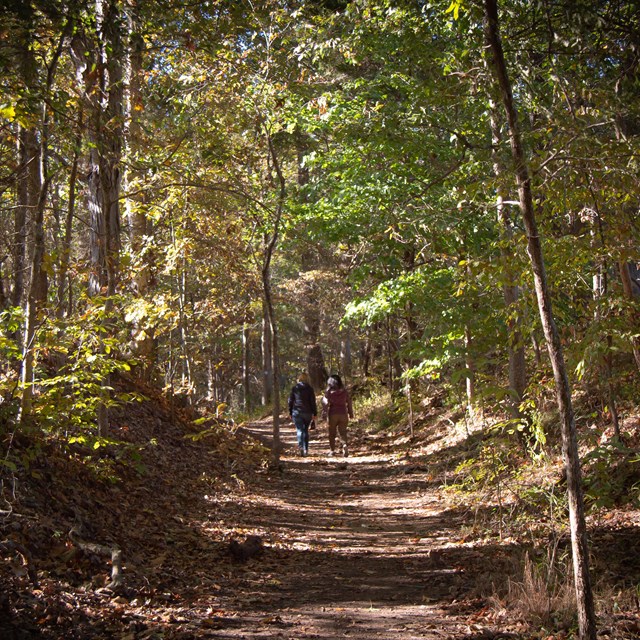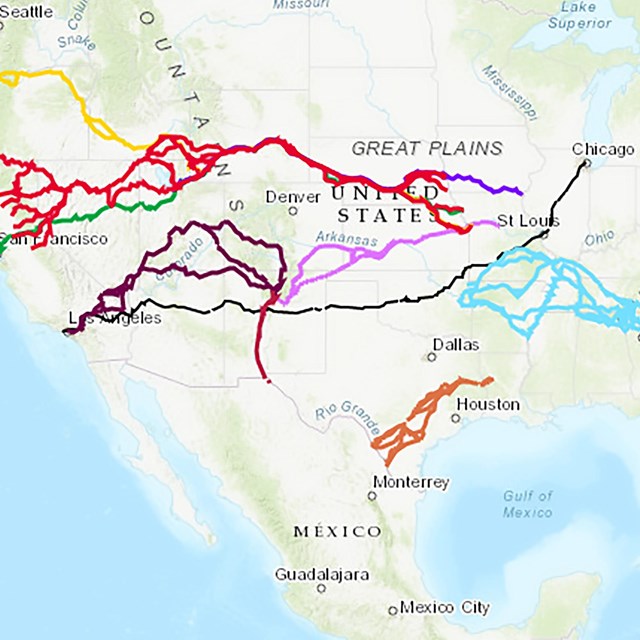Last updated: May 21, 2023
Article
Trail of Tears: Georgia Itinerary
The Cherokee homelands include Georgia. Most of the sites relate to the round up routes along which the Cherokee were forcibly removed to camps. Most Cherokee are moved into 11 removal camps—10 in Tennessee and one in Alabama. The round ups were the start of an 800-mile journey. Other sites in Georgia showcase elements of Cherokee life or environment in the homelands.
Please note: Not all sites have phone numbers or websites. Some sites are private.
This itinerary connects to the Find Your Park! Georgia, Tennessee, Alabama rack card.
Trip Itinerary
- Trail Of Tears National Historic Trail
New Echota State Park

In 1825, the Cherokee national legislature established a capital here. Visitors can tour several original and reconstructed buildings, including the council house, courthouse, print shop, missionary Samuel Worcester’s home, and an 1805 store, along with smoke houses, corn cribs, and barns. In the site’s visitor center, guests can view interpretive exhibits and a 17-minute film.
- Trail Of Tears National Historic Trail
Chieftains Museum Major Ridge Home

The Chieftains Museum tells the story of the influential Ridge family, including Major Ridge, his prominent son John Ridge, and the Trail of Tears, as well as subsequent history of the home and region. Major Ridge was one of the Treaty Party leaders who signed the 1835 Treaty of New Echota that resulted in Cherokee removal. The park-like venue has a museum and the site of the Ridge family ferry on the river.
- Trail Of Tears National Historic Trail
Running Waters John Ridge Home

At the time of the Cherokee removal in 1838, John Ridge was one of the most influential leaders in the Cherokee Nation. The Treaty Party formed at Running Waters, the home of John Ridge, where they conducted their business and discussed in open council the terms of the Treaty of New Echota. This is a private residence and is closed to the public.
- Trail Of Tears National Historic Trail
Cave Spring, Georgia
- Trail Of Tears National Historic Trail
Cedartown Encampment Removal Site
The Cedartown Encampment and Removal Site was one of fourteen forts and camps in Georgia the held forced groups of Cherokee before sending them to larger camps in southeastern Tennessee. The camp, an ad hoc military installation, operated during the late spring and early summer of 1838. Two outdoor exhibits interpret the removal camp.
- Trail Of Tears National Historic Trail
Funk Heritage Center
Funk Heritage Center of Reinhardt University is Georgia's Official Frontier and Southeastern Indian Interpretive Center. It is located on the Reinhardt University campus. It has dioramas and a film explaining 12,000 years of American Indian life in Georgia. Also, see exhibits that include historic artifacts and a large petroglyph found in the Hickory Log District of the old Cherokee Nation.
- Trail Of Tears National Historic Trail
Fort Newnan, the Trail of Tears
Fort Newnan was built in 1838 in the Hickory Log District of the Cherokee Nation and was likely at what is now the junction of Highway 136 and Antioch Church Road, east of and adjacent to the present-day Blaine Masonic Lodge. The Trail fo Tears historic route follows Highway 136 through this area. The fort was constructed along the path that would become the Trail of Tears in order to hold refugee Native Americans before their forced removal from Georgia.
- Trail Of Tears National Historic Trail
Rockdale Plantation (George Adair Home)
The earliest known owner of the property was George W. Adair, a Cherokee settler who owned five slaves. This 47-acre property includes an 18-room structure (known as the Freeman-Hurt-Evans House) dating from 1785, a “Travelers Rest” house dating from the 1830s, and two other historic buildings. The earliest known owner of the property was George W. Adair, a Cherokee settler who owned five slaves. This is a private residence and is closed to the public.
- Trail Of Tears National Historic Trail
Fort Gilmer, the Trail of Tears
- Trail Of Tears National Historic Trail
Chief Vann House

James Vann, a member of the Cherokee elite, built this two-story brick mansion in 1804. A 3,000-square foot interpretive center includes exhibits about the Vann family, Cherokee Nation, and Trail of Tears. Visitors receive guided tours of the historic house. The 23-acre park also includes outbuildings related to plantation operations.









